Published on 15 Sep 2024 | Last updated on 16 Sep 2024
Aging Eyes: 5 Common Signs and How to Reverse Them
- ByMedical Content Team
- Medically Reviewed byDr. Sabine Kulhanek
Fact checked
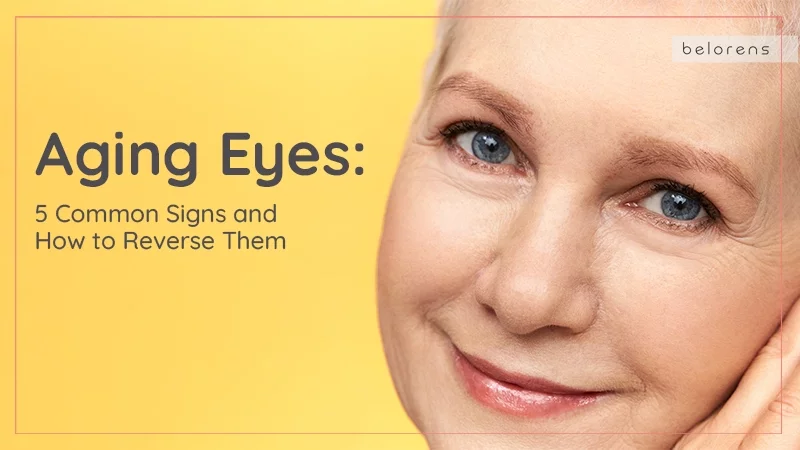
Have you ever looked in the mirror and felt disheartened by the first signs of aging appearing around your eyes? The eyes are often considered the windows to the soul, and when they begin to show signs of aging, it can impact not only your appearance but also your self-confidence. Perhaps you’ve noticed the fine lines creeping in at the corners, or those dark circles that once appeared after a sleepless night now seem permanent. These subtle changes can feel like a significant blow to your confidence.
Understanding how and why these changes occur is the first step in addressing them effectively. In this blog post, we will delve into the common signs of aging around the eyes, exploring their causes and what they mean for your overall skin health. From fine lines and wrinkles to puffiness and drooping eyelids, we’ll cover it all. Additionally, we’ll provide practical tips and solutions to help you maintain a youthful and vibrant appearance.
By the end of this post, you’ll have a clearer understanding of the aging process, preventative measures you can take, and the various treatment options available to keep your eyes looking bright and youthful.
Understanding the aging process
Aging is a natural and inevitable process that affects every part of our body, including the delicate skin around our eyes. This area is particularly vulnerable due to its thinness and constant exposure to environmental factors. As we age, several changes occur in the skin's structure and function, contributing to visible signs of aging.
Collagen and elastin, the proteins responsible for skin's firmness and elasticity, gradually decrease with age. This reduction leads to a loss of support in the skin, making it more prone to sagging and the formation of fine lines and wrinkles. Additionally, the skin's ability to retain moisture diminishes over time, resulting in dryness and a rougher texture.
Environmental factors such as sun exposure, pollution, and lifestyle choices also play a significant role in accelerating the aging process. Ultraviolet (UV) rays from the sun can damage the skin's DNA, leading to premature aging and the development of age spots and pigmentation. Pollution can cause oxidative stress, further breaking down collagen and elastin fibers. Smoking and poor diet contribute to the degradation of skin health, while lack of sleep and stress can exacerbate the signs of aging around the eyes.
Common signs of aging around the eyes
The eyes are often the first area to show visible signs of aging. This is due to the delicate and thin skin surrounding them, which is more susceptible to the effects of time and environmental factors. Here are some of the most common signs of aging around the eyes:
Fine lines and wrinkles
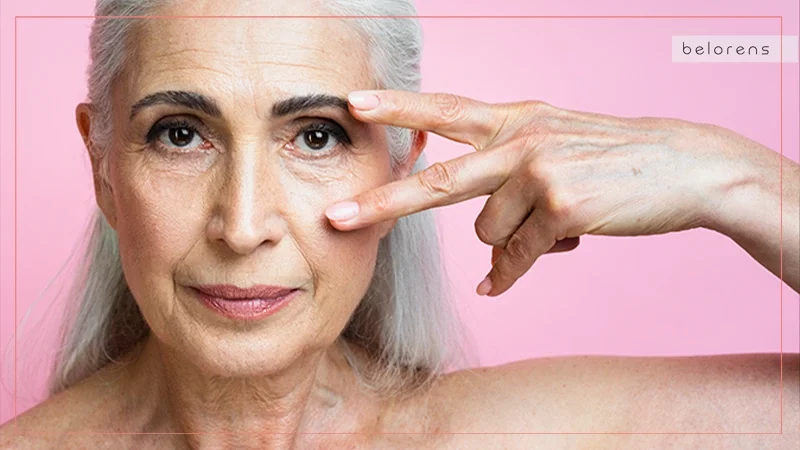
Fine lines and wrinkles are often the first and most noticeable signs of aging around the eyes. These lines typically appear at the outer corners of the eyes and are commonly referred to as crow’s feet. They can also develop under the eyes and along the upper eyelids.
The primary cause of fine lines and wrinkles is the natural aging process. As we age, the production of collagen and elastin—proteins that provide structure and elasticity to the skin—decreases. This reduction leads to a loss of skin firmness and elasticity, making it more prone to developing lines and wrinkles.
Repetitive facial movements, such as squinting, smiling, and frowning, also contribute to the formation of fine lines around the eyes. Each time we make these expressions, the skin folds and creases. Over time, and with the natural decline in collagen and elastin, these creases become permanent lines.
Environmental factors play a significant role as well. Prolonged exposure to ultraviolet (UV) rays from the sun can accelerate the breakdown of collagen and elastin fibers, leading to premature aging and deeper wrinkles. Pollution and other environmental aggressors can cause oxidative stress, further damaging the skin’s structural components.
Lifestyle choices, such as smoking, poor diet, and inadequate skincare routines, can exacerbate the formation of fine lines and wrinkles. Smoking, for example, reduces blood flow to the skin and damages collagen and elastin, while a diet lacking in essential nutrients can impair skin health and regeneration.
Fine lines around the eyes are typically shallow and appear as small, thin lines on the skin’s surface. They are often most noticeable when making facial expressions. Wrinkles, on the other hand, are deeper and more pronounced, becoming visible even when the face is at rest. Crow’s feet, which are the fine lines radiating from the outer corners of the eyes, are among the most common types of wrinkles in this area.
Treatments for eye fine lines and wrinkles
Treating fine lines and wrinkles around the eyes involves skincare routines, lifestyle adjustments, and professional treatments. A consistent skincare routine with retinoids, peptides, hyaluronic acid, and antioxidants is essential. Retinoids boost collagen, reducing fine lines, while peptides promote collagen synthesis, and hyaluronic acid hydrates and plumps the skin. Antioxidants protect against free radical damage.
Sun protection is crucial; daily use of high SPF sunscreen, along with wearing sunglasses and hats, protects the delicate skin around the eyes from UV rays. A healthy lifestyle, including a balanced diet rich in vitamins and antioxidants, proper hydration, adequate sleep, and avoiding smoking and excessive alcohol, supports skin health.
For more intensive treatments, options like chemical peels, microdermabrasion, and laser therapy stimulate collagen production and improve skin texture. Minimally invasive treatments, such as Botox and dermal fillers, provide quick solutions by relaxing muscles and restoring volume, smoothing wrinkles, and enhancing the under-eye contour.
Dark circles
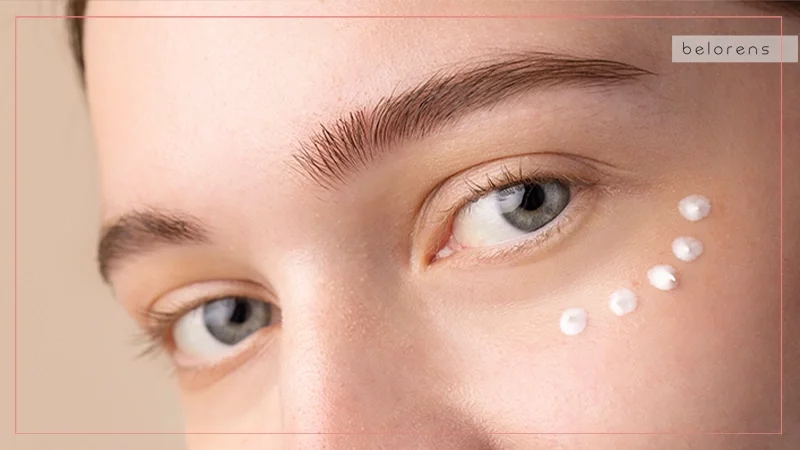
As we age, the skin around our eyes is often one of the first areas to show visible signs of aging, including the development of dark circles. Age-related dark circles under the eyes can be particularly challenging to manage, as they result from a combination of factors that change the skin's structure and appearance over time. These circles can make a person look tired, aged, and unhealthy.
The primary causes of age-related dark circles include thinning skin, loss of fat and volume, decreased blood circulation, hyperpigmentation, and structural changes. With age, the skin loses collagen and elastin, becoming thinner and more translucent. This thinning makes the blood vessels beneath the skin more visible, creating a darkened appearance under the eyes. Additionally, the loss of fat pads under the eyes leads to a hollowed or sunken appearance, creating shadows that exacerbate the look of dark circles. As circulation slows with age, blood can pool in the delicate capillaries under the eyes, giving the area a bluish or purplish tint.
Increased melanin production can also occur with age, leading to pigmentation issues. Chronic sun exposure over the years also contributes to this pigmentation. The natural sagging of skin and weakening of muscles around the eyes cause the formation of bags and puffiness, which cast shadows and highlight dark circles. Accumulated lifestyle habits over the years, such as lack of sleep, poor diet, smoking, and alcohol consumption, can worsen the appearance of dark circles.
Age-related dark circles often appear as a combination of pigmentation and structural shadows. They can be more pronounced and persistent compared to dark circles caused by temporary factors like lack of sleep or allergies. These dark circles may present as a bluish, purplish, or brownish tint under the eyes, accompanied by hollowness and fine lines.
How to treat age-related dark circles?
Addressing age-related dark circles involves adopting a comprehensive skincare routine, including products with ingredients like retinoids, peptides, vitamin C, and hyaluronic acid. These ingredients help improve skin thickness, boost collagen production, and reduce pigmentation. Daily use of sunscreen and wearing sunglasses can protect the skin from further sun damage and prevent exacerbation of pigmentation.
Maintaining a balanced diet rich in vitamins and antioxidants, staying hydrated, getting enough sleep, and avoiding smoking and excessive alcohol can significantly improve skin health and reduce the severity of dark circles. Keeping the skin well-hydrated with moisturizers improves its appearance and makes dark circles less noticeable. Applying cold compresses, cucumber slices, or chilled tea bags can temporarily reduce puffiness and lighten the appearance of dark circles. Gentle massage with an eye cream can also promote better circulation.
For more persistent age-related dark circles, professional treatments may be necessary. Options include chemical peels to improve skin texture and reduce pigmentation, laser therapy to target pigmentation and boost collagen production, microneedling to stimulate collagen and elastin production, and dermal fillers to address volume loss and reduce hollowness under the eyes. Blepharoplasty is a surgical option to remove excess skin and fat, improving the overall contour of the under-eye area.
Eye bags
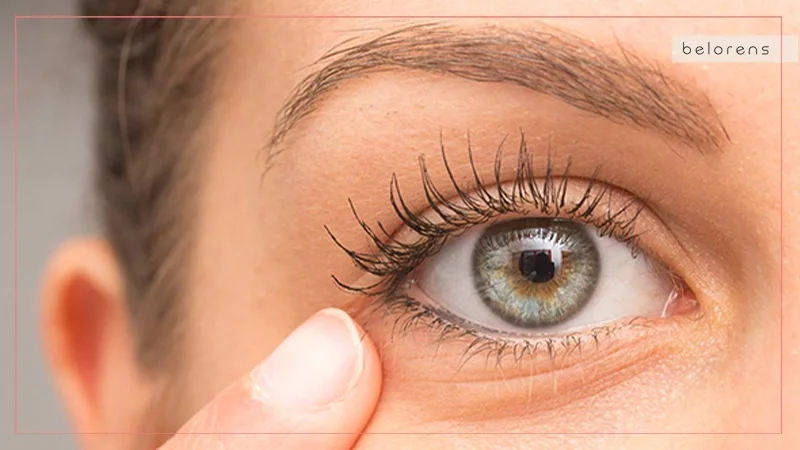
Eye bags are a common age-related concern as the skin and underlying structures around the eyes undergo changes over time. These bags are characterized by puffiness and swelling under the eyes, often making individuals look tired or older than they are.
One of the main causes of bags under the eyes is the natural aging process. As we age, the tissues around our eyes, including the muscles supporting the eyelids, weaken. This weakening allows normal fat that helps support the eyes to move into the lower eyelids, causing them to appear puffy. Additionally, the skin loses elasticity and collagen, making it thinner and more prone to sagging.
Fluid retention also contributes to the formation of eye bags. As circulation slows with age, fluid can accumulate in the area under the eyes, leading to swelling and puffiness. Lifestyle factors such as lack of sleep, high salt intake, and allergies can exacerbate this fluid retention.
Gravity plays a role as well. Over time, gravity pulls down the skin and fat around the eyes, which can cause the lower eyelids to sag and form bags. The combination of these factors results in the noticeable puffiness and swelling associated with age-related eye bags.
Age-related eye bags often appear as persistent puffiness under the eyes, accompanied by sagging skin and a hollowed appearance. They may be more pronounced in the morning due to overnight fluid retention and can vary in severity depending on factors like sleep quality, diet, and overall health.
Prevention and treatment
Preventing and treating age-related eye bags involves lifestyle adjustments, skincare, home remedies, and professional treatments. Maintaining a healthy lifestyle is crucial. Adequate sleep, reduced salt intake, hydration, and allergy management minimize fluid retention and improve puffy eyes. Elevating the head while sleeping prevents fluid pooling.
Incorporating skincare products with caffeine, retinoids, peptides, and hyaluronic acid can improve skin firmness, elasticity, and hydration. Home remedies like cold compresses, cucumber slices, and chilled tea bags reduce puffiness by constricting blood vessels, while gentle massage promotes circulation.
For persistent eye bags, professional treatments may be necessary. Non-invasive options like chemical peels, laser therapy, and radiofrequency treatments tighten skin and reduce puffiness by stimulating collagen production. Minimally invasive procedures like dermal fillers address volume loss and hollowing, smoothing the under-eye area. In severe cases, surgical intervention such as blepharoplasty removes excess fat and tightens skin, providing long-lasting results.
Also Read: Celebrities with Almond Eyes: A Glimpse into Timeless Elegance
Drooping eyelids
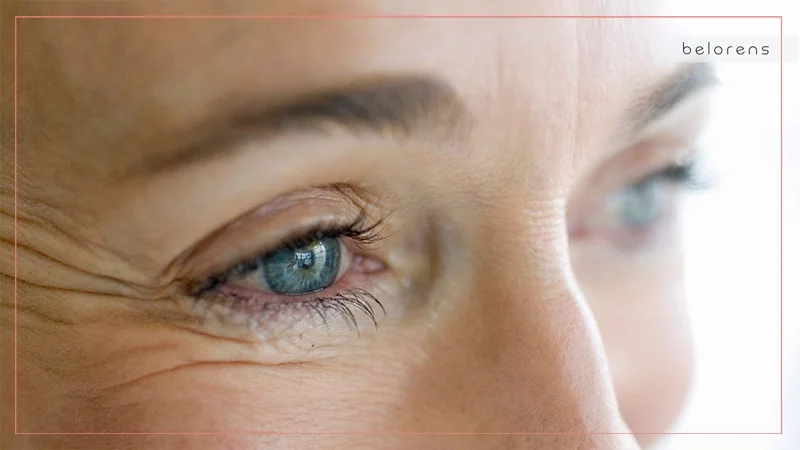
Drooping eyelids, also known as ptosis, are a common sign of aging that can significantly affect both appearance and vision. As the skin and muscles around the eyes weaken over time, the eyelids may sag, giving a tired or aged look. This condition can affect both the upper and lower eyelids.
The primary cause of drooping eyelids is the natural aging process. As we age, the muscles responsible for lifting the eyelids, known as the levator muscles, can weaken or stretch. This weakening reduces their ability to hold the eyelids in place, causing them to droop. Additionally, the skin loses elasticity and collagen, which further contributes to sagging.
Genetics can also play a role in drooping eyelids. Some people may be predisposed to this condition due to inherited traits that affect the structure and strength of the eyelid muscles and skin.
Medical conditions and lifestyle factors can exacerbate drooping eyelids. Neurological disorders, such as myasthenia gravis, can impair the function of the muscles responsible for eyelid movement. Chronic conditions like diabetes or stroke can also affect the nerves and muscles, leading to ptosis. Smoking, poor diet, and excessive sun exposure can accelerate the aging process, weakening the skin and muscles around the eyes.
Drooping eyelids can vary in severity, from a slight sagging that affects only the appearance to a more pronounced droop that can interfere with vision. The condition may affect one or both eyes. In severe cases, the drooping eyelid can cover part of the pupil, obstructing vision and causing strain or difficulty with daily activities.
Individuals with drooping eyelids may also experience additional symptoms such as eye fatigue, difficulty keeping the eyes open, and the need to tilt the head back to see properly. The condition can lead to a tired or aged appearance, impacting self-confidence and facial expressions.
Prevention and treatment
Preventing and treating drooping eyelids involves lifestyle changes, skincare practices, and medical interventions. Maintaining a healthy lifestyle with a diet rich in vitamins and antioxidants, staying hydrated, and avoiding smoking and excessive alcohol helps prevent premature weakening of eyelid muscles and skin. Protecting the skin from sun exposure with sunscreen and sunglasses can slow aging.
Incorporating skincare products with retinoids, peptides, and hyaluronic acid can improve skin texture and support collagen production, reducing sagging. For more pronounced drooping, non-surgical options like eyelid tapes or adhesives provide temporary cosmetic improvement. Minimally invasive procedures like Botox can offer temporary relief for mild to moderate ptosis by relaxing the muscles.
For significant impact on vision or appearance, surgical intervention may be necessary. Blepharoplasty removes excess skin, muscle, and fat, lifting and tightening the eyelids, while ptosis surgery targets and strengthens the levator muscles for a more permanent solution
Loss of elasticity and firmness around the eyes
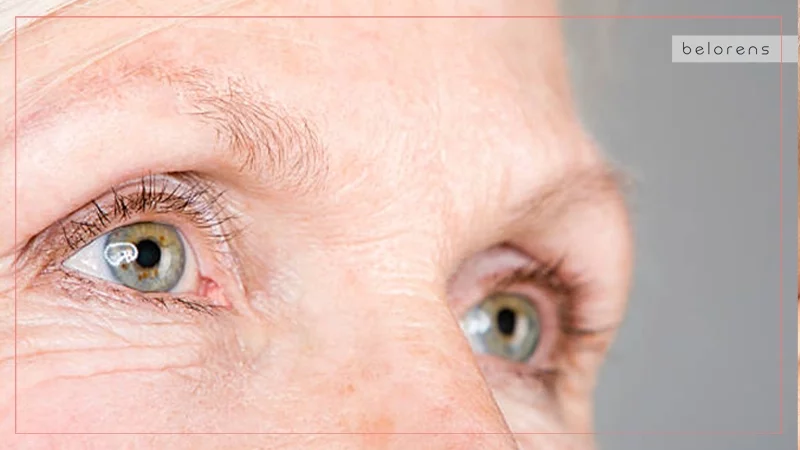
As we age, one of the most noticeable changes in our skin, particularly around the eyes, is the loss of elasticity and firmness. This phenomenon contributes significantly to the appearance of aging, resulting in sagging skin, fine lines, and wrinkles.
The primary cause of reduced elasticity and firmness is the natural aging process, which affects the structural components of the skin. Collagen and elastin are the proteins responsible for maintaining the skin's strength, flexibility, and ability to bounce back after stretching. As we age, the production of these proteins decreases, leading to weaker skin that sags and forms wrinkles more easily.
Environmental factors such as prolonged sun exposure and pollution accelerate the breakdown of collagen and elastin fibers. Ultraviolet (UV) radiation from the sun penetrates the skin and damages the DNA in skin cells, leading to the degradation of collagen and the formation of free radicals, which further harm the skin's structural integrity.
Lifestyle choices also play a crucial role. Smoking, for example, introduces toxins that reduce blood flow to the skin and contribute to the breakdown of collagen and elastin. Poor diet, particularly one lacking in essential nutrients like vitamins C and E, which are vital for skin health, can exacerbate the loss of firmness and elasticity. Dehydration, caused by inadequate water intake, also makes the skin less plump and more prone to sagging.
The loss of elasticity and firmness around the eyes manifests in several ways. The skin becomes thinner and more translucent, making underlying blood vessels more visible and contributing to a tired appearance. Fine lines and wrinkles, particularly crow's feet at the outer corners of the eyes, become more pronounced. The upper eyelids may start to droop, and the lower eyelids can develop a hollowed or sunken look due to the loss of underlying fat and structural support.
How to tighten the skin around the eyes?
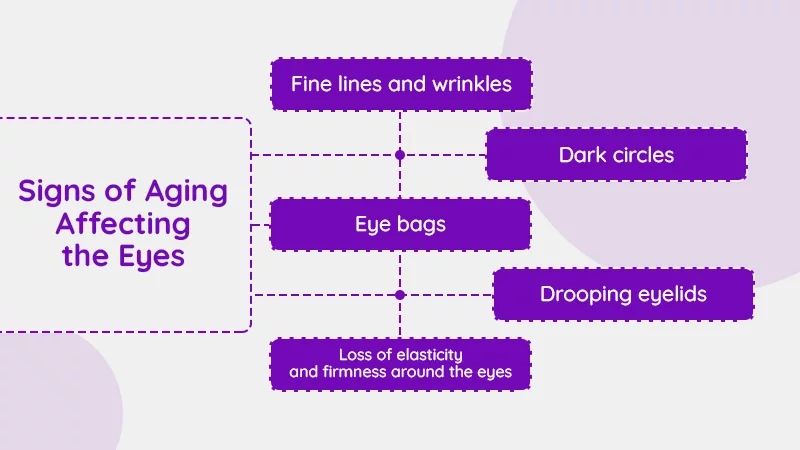
Preventing and treating the loss of elasticity and firmness involves skincare, lifestyle changes, and professional treatments. A targeted skincare routine with retinoids, peptides, and antioxidants helps stimulate collagen and protect against damage. Retinoids promote cell turnover and collagen synthesis, improving skin texture and elasticity. Peptides support collagen and elastin production, while antioxidants neutralize free radicals.
Sun protection with sunscreen and protective clothing is crucial to prevent collagen degradation. A healthy lifestyle, including a diet rich in antioxidants, proper hydration, and avoiding smoking and alcohol, supports skin health.
For significant loss, professional treatments like chemical peels, laser therapy, and microneedling can stimulate collagen production. Minimally invasive procedures like dermal fillers restore volume and smooth out wrinkles. In severe cases, surgical options like blepharoplasty remove excess skin and fat, tightening the skin for a youthful contour




